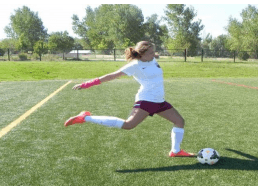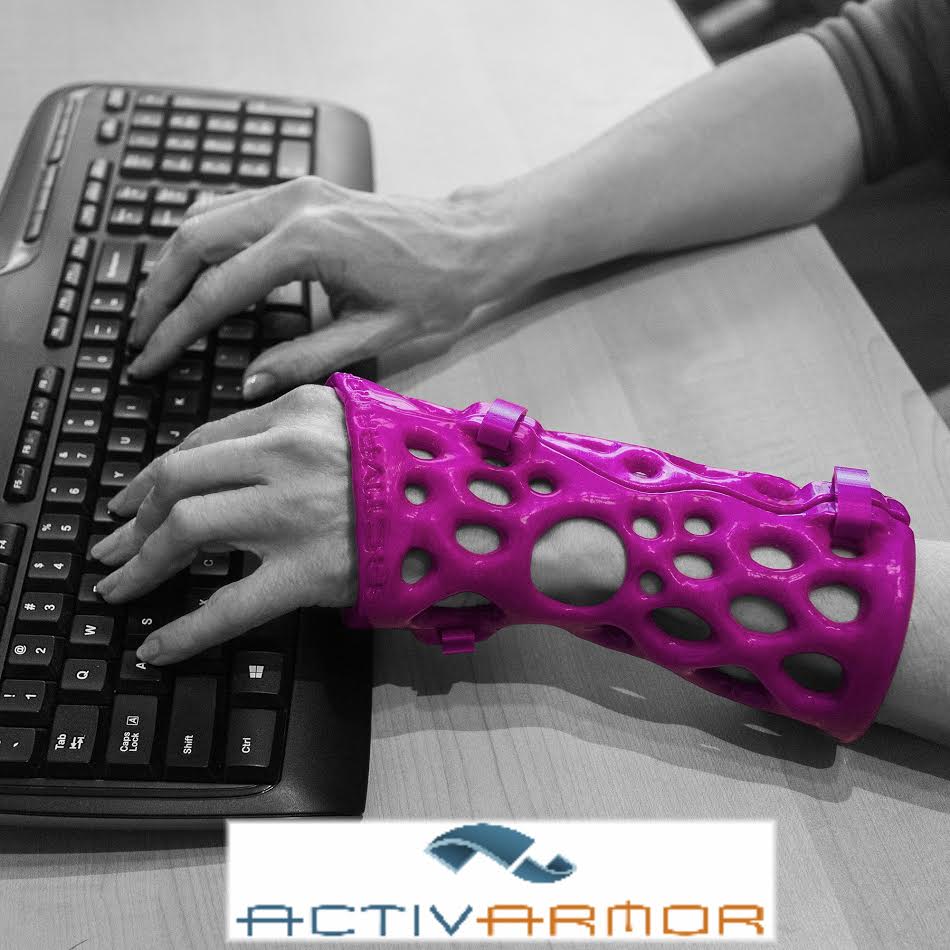 We’ve seen 3D scanning and 3D printing used in the medical field as a way to make life easier on injured patients, like this custom sleep mask designed for a patient suffering from Graves’ disease and this 3D printed wrist brace. 3D printed casts can certainly offer patients a lot of benefits that the traditional plaster cast can’t, such as being water-safe and non-permeable (no one likes the smell of body sweat trapped inside plaster). Colorado-based company ActivArmor has completed the necessary field tests for its 3D printed casts, and though the casts have previously been available across the Colorado Front Range, we learned this week that the company will be going nationwide with the versatile new casts later this year.
We’ve seen 3D scanning and 3D printing used in the medical field as a way to make life easier on injured patients, like this custom sleep mask designed for a patient suffering from Graves’ disease and this 3D printed wrist brace. 3D printed casts can certainly offer patients a lot of benefits that the traditional plaster cast can’t, such as being water-safe and non-permeable (no one likes the smell of body sweat trapped inside plaster). Colorado-based company ActivArmor has completed the necessary field tests for its 3D printed casts, and though the casts have previously been available across the Colorado Front Range, we learned this week that the company will be going nationwide with the versatile new casts later this year.
ActivArmor casts are custom fit support devices that are unique to each patient’s body. They are “mapped to the contours of the limb or injuries requiring stabilization and support.” Looking through the images available on their website, it appears that ActivArmor casts are only available for finger, hand, wrist, and arm injuries, and not for broken legs. The injured limb is 3D mapped so each client can get an exact fit, unlike options such as progressive layers of molded tape or low temperature thermoplastic. These Class 1 splints are fabricated from 100% high temperature ABS plastic, and use indications note that they are “not intended to provide bone-level strength to the extremity.”
 ActivArmor is unique for a number of reasons. First, it is obviously much easier to observe the condition of a patient’s skin, and a cast’s exact fit “allows the tissues to remain in the desired position for optimal rest and healing.” Doctors are able to better immobilize specific areas that would not be possible with prefabricated casts; it also helps doctors reduce the need to maintain and store an inventory of casts.
ActivArmor is unique for a number of reasons. First, it is obviously much easier to observe the condition of a patient’s skin, and a cast’s exact fit “allows the tissues to remain in the desired position for optimal rest and healing.” Doctors are able to better immobilize specific areas that would not be possible with prefabricated casts; it also helps doctors reduce the need to maintain and store an inventory of casts.
Through its patent-pending closing mechanism, the ActivArmor device can be designed to be easily removable. As previously mentioned, 3D printed casts like ActivArmor are generally safe for use in water, so patients can bathe, and even swim, without worrying that the device will lose the ability to provide support to their injury.
 This is pretty interesting: if someone with a medical or food handling job needs a cast, ActivArmor can also be cold sterilized for safe use in their field! When Pro Circuit Rider Adam Cianciarulo broke his wist this summer, he used an ActivArmor cast to keep on riding.
This is pretty interesting: if someone with a medical or food handling job needs a cast, ActivArmor can also be cold sterilized for safe use in their field! When Pro Circuit Rider Adam Cianciarulo broke his wist this summer, he used an ActivArmor cast to keep on riding.
Cianciarulo said, “My brace has given me the freedom to do things I couldn’t do with a standard cast while giving me the support I need to protect my wrist fracture. I love it and would recommend it to anyone with any problem requiring extra support!”
Some of the other positive features of the ActivArmor devices include:
- Comfortable
- Available in multiple colors
- Hygienic
- Ventilated
- Lightweight
- Temperature resistant
- Quick, painless application and removal
- Reusable
The ActivArmor website says that the device is covered by insurance. Doctors can prescribe ActivArmor to their patients; the prescription needs to include the diagnosis code and any special design or fit instructions. They can send their patients to one of the company’s partnering clinics, or become a partner themselves. Referring physicians can contact the company to request ActivArmor script pads.
 Some of the common injuries that can be treated with ActivArmor include thumb fractures and dislocations, collateral ligament injuries, sprained wrists, and carpal tunnel syndrome. The website notes that “ActivArmor is not suggested for use when there is acute edema or may be present in the future. For athletes, it is not intended for use in activities that incur high force impact or torque on the device.” These devices have not been formally tested for acute injuries, and are only labeled for external use to provide “support, stability, and immobilization for extremities.”
Some of the common injuries that can be treated with ActivArmor include thumb fractures and dislocations, collateral ligament injuries, sprained wrists, and carpal tunnel syndrome. The website notes that “ActivArmor is not suggested for use when there is acute edema or may be present in the future. For athletes, it is not intended for use in activities that incur high force impact or torque on the device.” These devices have not been formally tested for acute injuries, and are only labeled for external use to provide “support, stability, and immobilization for extremities.”
If a doctor prescribes an ActivArmor device, the first step is having a 3D scan of the patient’s injured limb performed. This does not require any contact with skin, and should take less than a minute to get a precise, custom 3D body contour. The mapped image, along with any special design instructions for the device, is uploaded to ActivArmor, and the patient is then put in a temporary splint or bivalve cast while waiting for their device to be fabricated and shipped. The completed custom device is generally received by the provider within 3-4 business days.
3D printed medical devices offer customized care and can optimize healing when correctly created and worn. While some individuals with medical experience have seen success in making their own 3D printed casts, please note that you should always consult your doctor for injury. Discuss in the ActivArmor forum at 3DPB.com.
Subscribe to Our Email Newsletter
Stay up-to-date on all the latest news from the 3D printing industry and receive information and offers from third party vendors.
You May Also Like
Gorilla Sports GE’s First 3D Printed Titanium Cast
How do you help a gorilla with a broken arm? Sounds like the start of a bad joke a zookeeper might tell, but it’s an actual dilemma recently faced by...
Nylon 3D Printed Parts Made More Functional with Coatings & Colors
Parts 3D printed from polyamide (PA, Nylon) 12 using powder bed fusion (PBF) are a mainstay in the additive manufacturing (AM) industry. While post-finishing processes have improved the porosity of...
$25M to Back Sintavia’s Largest Expansion of Metal 3D Printing Capacity Since 2019
Sintavia, the digital manufacturing company specializing in mission-critical parts for strategic sectors, announced a $25 million investment to increase its production capacity, the largest expansion to its operations since 2019....
Velo3D Initiates Public Offering in a Bid to Strengthen Financial Foundations and Drive Future Growth
Velo3D (NYSE: VLD) has been among a number of publicly traded 3D printing firms that have attempted to weather the current macroeconomic climate. After posting a challenging financial report for 2023,...































